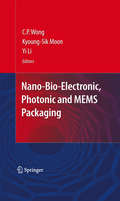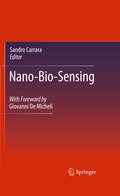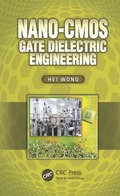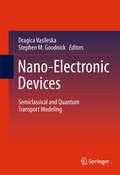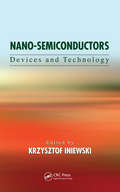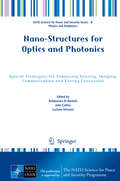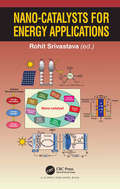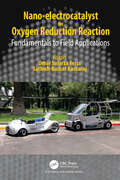- Table View
- List View
Nano-Bio- Electronic, Photonic and MEMS Packaging
by C. P. Wong Yi Grace Li Kyoung-Sik MoonNanotechnologies are being applied to the biotechnology area, especially in the area of nano material synthesis. Until recently, there has been little research into how to implement nano/bio materials into the device level. "Nano and Bio Electronics Packaging" discusses how nanofabrication techniques can be used to customize packaging for nano devices with applications to biological and biomedical research and products. Covering such topics as nano bio sensing electronics, bio device packaging, NEMs for Bio Devices and much more.
Nano-Bio-Sensing
by Sandro CarraraThe application of circuits and systems and engineering principles to problems in the medicine has led to the emergence of biomedical circuits and systems as an exciting and rapidly growing area of research. Nanotechnology provides new nano-structured materials with amazing properties. The properties offered by nanomaterials can be applied to develop advanced instrumentation for biomedical diagnostics and personalized therapy, as well as bio-sensing in the environment. Biotechnology provides new biochemical materials with novel properties to be applied to develop new performances in sensing techniques. These advancements in Nano- and Bio- technologies will lead to new concepts and applications for nano-bio-sensing systems. This book offers an invaluable reference to the state-of-the-art applications of nano-bio-sensing. It brings together expertise of researchers from the fields of nano-electronics and bio-technology, providing multidisciplinary content from nano-structures fabrication to bio-sensing applications.
Nano-Biofortification for Human and Environmental Health (Sustainable Plant Nutrition in a Changing World)
by Hassan El-Ramady Vishnu D. Rajput Tatiana Minkina Sudhir K. Upadhyay Bilal Ahmed Saglara MandzhievaNanotechnology has shown great potential to alleviate increasing pressure to meet food needs for our increasing human population, Novel agricultural innovations are required to enhance the health of edible crops and per unit area yield without impacting the associated environment in a negative way. Recent advancements in nanotechnology-based agricultural solutions have proven to help overcome the problems in agriculture that are associated with run-off of essential fertilizers from agricultural soils, low nutrient accumulation by crops, as well as to control insects, pests, and seasonal biotic factors, treatment of wastewater used for irrigation, plant uptake of xenobiotics (heavy metals, pesticides, industrial chemicals, drugs, and so on) that may be present in contaminated soils. Additionally, the consumption of such food crops may result in malnourishment and plant-mediated transfer of toxic substances among humans especially in underprivileged and rural populations. Agents to stimulate plant growth include various types of nanomaterials such as carbon nanotubes, metal, and metal-oxide nanoparticles. Applications of particular nutrients or elements in crop plants can be shown to aid human nourishment (either by directly inducing its uptake or indirectly through enhancing the intracellular levels of other associated elements that ultimately boost the synthesis of the desired nutrient in plants). It is also important to consider the competence and fate of nanomaterials in soil ecosystems. The entry route of nanomaterials into the environment includes both natural and anthropogenic sources. In order to achieve sustainable and safe use of nanotechnological products in agriculture, similar environmental conditions must be simulated on lab scale with the careful selection of organisms related to agriculture. Thus, emphasis should be placed on the judicial use of nano-enabled products without compromising the sustainability of the environment and human health. This comprehensive book highlights recent field research as well as contributions from academicians in the lab. This book addresses the major aspects related to nanotechnology, biofortification of crops, and human and environmental health.
Nano-Biomaterials in Tissue Repair and Regeneration: Clinical Aspect for Hard Tissues Materials (Tissue Repair and Reconstruction)
by Feza Korkusuz Necdet Sağlam Mesut ŞamThis book covers the clinical application of nano-biomaterials in hard tissue repair and regeneration which are materials designed to interact with biological systems to restore and regenerate damaged tissues. These materials serve as scaffolds that mimic the natural extracellular matrix (ECM), providing structural support and biochemical cues necessary for cellular activities. The physical and chemical properties of biomaterials can be tailored to specific applications, such as bone regeneration, cartilage repair, wound healing, and organ transplantation. Biomaterials influence cell behavior and tissue formation by controlling factors like mechanical strength, porosity, and surface topography. This book is suitable to students, academics, and clinical practitioners who are interested in the advancements of regenerative medicine.
Nano-Biomaterials in Tissue Repair and Regeneration: Clinical Aspect—Soft Tissues (Tissue Repair and Reconstruction)
by Feza Korkusuz Necdet Sağlam Mesut ŞamThis book covers the clinical application of nano-bio-materials in hard tissue repair and regeneration which are materials designed to interact with biological systems to restore and regenerate damaged tissues. These materials serve as scaffolds that mimic the natural extracellular matrix (ECM), providing structural support and biochemical cues necessary for cellular activities. The physical and chemical properties of biomaterials can be tailored to specific applications, such as bone regeneration, cartilage repair, wound healing, and organ transplantation. Biomaterials influence cell behavior and tissue formation by controlling factors like mechanical strength, porosity, and surface topography. This book is suitable for students, academics, and clinical practitioners who are interested in the advancements of regenerative medicine.
Nano-Biomaterials in Tissue Repair and Regeneration: Materials Characterization (Tissue Repair and Reconstruction)
by Feza Korkusuz Necdet Sağlam Mesut ŞamThis book covers the characterization of nano-biomaterials in tissue repair and regeneration which are materials designed to interact with biological systems to restore and regenerate damaged tissues. These materials serve as scaffolds that mimic the natural extracellular matrix (ECM), providing structural support and biochemical cues necessary for cellular activities. The physical and chemical properties of biomaterials are tailored to specific applications, such as bone regeneration, cartilage repair, wound healing, and organ transplantation. Biomaterials influence cell behavior and tissue formation by controlling factors like mechanical strength, porosity, and surface topography. This book provides an overview of the topic from the biomaterials’ characterization point of view and is suitable for students, academics, and clinical practitioners who are interested in the advancements of regenerative medicine.
Nano-Biomaterials in Tissue Repair and Regeneration: Surgical Aspect for Hard Tissues (Tissue Repair and Reconstruction)
by Feza Korkusuz Necdet Sağlam Mesut ŞamThis book covers the clinical application of nano-biomaterials in hard tissue repair and regeneration which are materials designed to interact with biological systems to restore and regenerate damaged tissues. These materials serve as scaffolds that mimic the natural extracellular matrix (ECM), providing structural support and biochemical cues necessary for cellular activities. The physical and chemical properties of biomaterials can be tailored to specific applications, such as bone regeneration, cartilage repair, wound healing, and organ transplantation. Biomaterials influence cell behavior and tissue formation by controlling factors like mechanical strength, porosity, and surface topography. This book is suitable to students, academics, and clinical practitioners who are interested in the advancements of regenerative medicine.
Nano-CMOS Gate Dielectric Engineering
by Hei WongAccording to Moore’s Law, not only does the number of transistors in an integrated circuit double every two years, but transistor size also decreases at a predictable rate. At the rate we are going, the downsizing of CMOS transistors will reach the deca-nanometer scale by 2020. Accordingly, the gate dielectric thickness will be shrunk to less than half-nanometer oxide equivalent thickness (EOT) to maintain proper operation of the transistors, leaving high-k materials as the only viable solution for such small-scale EOT. This comprehensive, up-to-date text covering the physics, materials, devices, and fabrication processes for high-k gate dielectric materials, Nano-CMOS Gate Dielectric Engineering systematically describes how the fundamental electronic structures and other material properties of the transition metals and rare earth metals affect the electrical properties of the dielectric films, the dielectric/silicon and the dielectric/metal gate interfaces, and the resulting device properties. Specific topics include the problems and solutions encountered with high-k material thermal stability, defect density, and poor initial interface with silicon substrate. The text also addresses the essence of thin film deposition, etching, and process integration of high-k materials in an actual CMOS process. Fascinating in both content and approach, Nano-CMOS Gate Dielectric Engineering explains all of the necessary physics in a highly readable manner and supplements this with numerous intuitive illustrations and tables. Covering almost every aspect of high-k gate dielectric engineering for nano-CMOS technology, this is a perfect reference book for graduate students needing a better understanding of developing technology as well as researchers and engineers needing to get ahead in microelectronic engineering and materials science.
Nano-Electronic Devices
by Stephen M. Goodnick Dragica VasileskaThis book surveys the advanced simulation methods needed for proper modeling of state-of-the-art nanoscale devices. It systematically describes theoretical approaches and the numerical solutions that are used in explaining the operation of both power devices as well as nano-scale devices. It clearly explains for what types of devices a particular method is suitable, which is the most critical point that a researcher faces and has to decide upon when modeling semiconductor devices.
Nano-Energetic Materials (Energy, Environment, and Sustainability)
by Avinash Kumar Agarwal Shantanu Bhattacharya T. Rajagopalan Vinay K. PatelThis book presents the latest research on the area of nano-energetic materials, their synthesis, fabrication, patterning, application and integration with various MEMS systems and platforms. Keeping in mind the applications for this field in aerospace and defense sectors, the articles in this volume contain contributions by leading researchers in the field, who discuss the current challenges and future perspectives. This volume will be of use to researchers working on various applications of high-energy research.
Nano-Engineering of High Strength Steels (Topics in Mining, Metallurgy and Materials Engineering)
by Wenwen SongThis book offers new insights into the process of adjusting nanostructures in high-strength steels to achieve enhanced mechanical properties. It summarizes the state-of-the-art nanoengineering approaches, such as precipitation engineering, interface engineering, and short-range ordering engineering. The book explores the nanostructure-process-property relationships in various high-strength steels, including TRIP/TWIP/MBIP in high-Mn steels (HMnS), medium-Mn steels (MMnS), bearing steels, tool steels, and more. The author investigates a novel approach to control the phase transformation process during deformation and/or thermal treatment in steels, employing both experimental and theoretical tools.
Nano-Insecticide: Today and Future Perspectives (Nanotechnology in the Life Sciences)
by Ram Prasad Perumal Vivekanandhan Patcharin Krutmuang Jayalakshmi KrishnanIn recent years, nanotechnology has emerged as a promising tool for combating insect pests in agriculture, public health, and urban environments. Nanomaterials offer unique properties which can be leveraged to develop targeted and environmentally sustainable pest control solutions. However, despite growing interest in this area, there remains a need for a comprehensive resource that synthesizes the latest research findings and practical applications of nanotechnology for insect pest control. Nano-Insecticide addresses this gap by providing a thorough overview of the diverse applications of nanotechnology in insect pest management. The book covers a wide range of topics, including nanoparticles for insecticide delivery and release, nanostructured materials for pest monitoring and detection, nanobiotechnology approaches for pest-specific targeting, environmental implications, safety considerations and more. Case studies and practical applications from various agricultural and urban settings are also featured. Each chapter is authored by leading experts in their respective fields, ensuring that the book reflects the latest advancements and perspectives in nanotechnology for insect pest control. This book serves as a valuable resource for researchers, practitioners, policymakers, and students interested in the intersection of nanotechnology and pest management. By providing a comprehensive overview of the current state-of-the-art and future directions in the field, Nano-Insecticide aims to stimulate further research and innovation in this critical area. It has the potential to significantly advance our understanding and application of novel pest management strategies.
Nano-Interconnect Materials and Models for Next Generation Integrated Circuit Design
by J. Ajayan Sandip Bhattacharya Fernando Avila HerreraAggressive scaling of device and interconnect dimensions has resulted in many low dimensional issues in the nanometer regime. This book deals with various new generation interconnect materials and interconnect modeling and highlights the significance of novel nano interconnect materials for 3D integrated circuit design. It provides information about advanced nanomaterials like carbon nanotube (CNT) and graphene nanoribbon (GNR) for the realization of interconnects, interconnect models, and crosstalk noise analysis. Features: Focusses on materials and nanomaterials utilization in next generation interconnects based on Carbon nanotubes (CNT) and Graphene nanoribbons (GNR). Helps readers realize interconnects, interconnect models, and crosstalk noise analysis. Describes Hybrid CNT and GNR based interconnects. Presents the details of power supply voltage drop analysis in CNT and GNR interconnects. Overviews pertinent RF performance and stability analysis. This book is aimed at graduate students and researchers in electrical and materials engineering, nano/microelectronics.
Nano-Optics for Enhancing Light-Matter Interactions on a Molecular Scale
by John Collins Luciano Silvestri Baldassare Di BartoloThis volume presents a considerable number of interrelated contributions dealing with the new scientific ability to shape and control matter and electromagnetic fields on a sub-wavelength scale. The topics range from the fundamental ones, such as photonic metamateriials, plasmonics and sub-wavelength resolution to the more applicative, such as detection of single molecules, tomography on a micro-chip, fluorescence spectroscopy of biological systems, coherent control of biomolecules, biosensing of single proteins, terahertz spectroscopy of nanoparticles, rare earth ion-doped nanoparticles, random lasing, and nanocoax array architecture. The various subjects bridge over the disciplines of physics, biology and chemistry, making this volume of interest to people working in these fields. The emphasis is on the principles behind each technique and on examining the full potential of each technique. The contributions that appear in this volume were presented at a NATO Advanced Study Institute that was held in Erice, Italy, 3-18 July, 2011. The pedagogical aspect of the Institute is reflected in the topics presented in this volume.
Nano-Semiconductors: Devices and Technology (Devices, Circuits, and Systems)
by Krzysztof IniewskiWith contributions from top international experts from both industry and academia, Nano-Semiconductors: Devices and Technology is a must-read for anyone with a serious interest in future nanofabrication technologies. Taking into account the semiconductor industry’s transition from standard CMOS silicon to novel device structures—including carbon nanotubes (CNT), graphene, quantum dots, and III-V materials—this book addresses the state of the art in nano devices for electronics. It provides an all-encompassing, one-stop resource on the materials and device structures involved in the evolution from micro- to nanoelectronics. The book is divided into three parts that address: Semiconductor materials (i.e., carbon nanotubes, memristors, and spin organic devices) Silicon devices and technology (i.e., BiCMOS, SOI, various 3D integration and RAM technologies, and solar cells) Compound semiconductor devices and technology This reference explores the groundbreaking opportunities in emerging materials that will take system performance beyond the capabilities of traditional CMOS-based microelectronics. Contributors cover topics ranging from electrical propagation on CNT to GaN HEMTs technology and applications. Approaching the trillion-dollar nanotech industry from the perspective of real market needs and the repercussions of technological barriers, this resource provides vital information about elemental device architecture alternatives that will lead to massive strides in future development.
Nano-Strategies for Addressing Antimicrobial Resistance: Nano-Diagnostics, Nano-Carriers, and Nano-Antimicrobials (Nanotechnology in the Life Sciences)
by Vinay Kumar Varsha Shriram Ravi Shukla Suresh GosaviAntibiotics, the backbone of modern clinical-medicine, are facing serious challenges from emerging antimicrobial-resistance (AMR), a complicated phenomenon expanding in bacterial species, from nosocomial to community origins, where microbes are no longer sensitive to a range of commonly used antibiotics. AMR has exploded in recent years and is posing a serious threat to human health and survival. This necessitates novel and effective ways of diagnosis, drug-delivery, and treatment; nanotechnology and advanced nanomaterials are hailed as a potent solution in containing AMR.The main thrust of this volume is to explain the most current research on the central theme of potential use of nano-approaches for diagnosis, detection, drug-delivery and as antimicrobial agents against drug-resistant pathogenic microbes. This book provides an integrated blend of basic and advanced information for students, scholars, scientists and practitioners, interested or already engaged in research in these areas. We have brought together leading international authors to present and highlight various aspects of nanotechnology in combating AMR in WHO-prioritized microbes. Topics range from advances in nanomaterial synthesis, characterization, functionalization and improvisation, as well as applications in sensing, diagnosis of AMR, and their therapeutic and drug-delivery potential against MDR and XDR microbial phenotypes.
Nano-Structures for Optics and Photonics
by John Collins Luciano Silvestri Baldassare Di BartoloThe contributions in this volume were presented at a NATO Advanced Study Institute held in Erice, Italy, 4-19 July 2013. Many aspects of important research into nanophotonics, plasmonics, semiconductor materials and devices, instrumentation for bio sensing to name just a few, are covered in depth in this volume The growing connection between optics and electronics, due to the increasing important role plaid by semiconductor materials and devices, find their expression in the term photonics, which also reflects the importance of the photon aspect of light in the description of the performance of several optical systems. Nano-structures have unique capabilities that allow the enhanced performance of processes of interest in optical and photonic devices. In particular these structures permit the nanoscale manipulation of photons, electrons and atoms; they represent a very hot topic of research and are relevant to many devices and applications. The various subjects bridge over the disciplines of physics, biology and chemistry, making this volume of interest to people working in these fields. The emphasis is on the principles behind each technique and on examining the full potential of each technique.
Nano-Surface Chemistry
by Morton RosoffContaining more than 2600 references and over 550 equations, drawings, tables, photographs, and micrographs, This book describes hierarchical assemblies in biology and biological processes that occur at the nanoscale across membranes and at interfaces. It covers recurrent themes in nanocolloid science, including self-assembly, construction of supra
Nano-Tera.ch: Engineering the Future of Systems for Health, Environment and Energy
by Anil Leblebici Patrick Mayor Martin Rajman Giovanni De MicheliThis book presents the overall vision and research outcomes of Nano-Tera.ch, which is a landmark Swiss federal program to advance engineering system and device technologies with applications to Health and the Environment, including smart Energy generation and consumption. The authors discuss this unprecedented nation-wide program, with a lifetime of almost 10 years and a public funding of more than 120 MCHF, which helped to position Switzerland at the forefront of the research on multi-scale engineering of complex systems and networks, and strongly impacted the Swiss landscape in Engineering Sciences.
Nano-catalyst for Energy Applications
by Rohit SrivastavaThis book comprises of chapters based on design of various advanced nano-catalysts and offers a development of novel solutions for a better sustainable energy future. The book includes all aspects of physical chemistry, chemical engineering and material science. The advances in nanoscience and nanotechnology help to find cost-effective and environmentally sound methods of converting naturally inspired resources into fuels, chemicals and energy. The book leads the scientific community to the most significant development in the focus research area. It provides a broad and in-depth coverage of design and development advanced nano-catalyst for various energy applications.
Nano-electrocatalyst for Oxygen Reduction Reaction: Fundamentals to Field Applications
by Sathish-Kumar Kamaraj Omar Solorza FeriaGlobal warming switches our reliance from fossil fuels to green, sustainable renewable energy sources. Because of its promising nature, high-efficiency nano-electrocatalysts have sparked interest in renewable energy. Hydrogen fuel cell/polymer electrolyte membrane (PEM) vehicles are the most environmentally conscious electromobility vehicles, with a high energy density and quick refuelling technology, prompting the auto industry to launch a variety of PEM fuel cell vehicles around the world. Oxygen reduction reaction (ORR) primary research interests include fuel cells and metal-air batteries. The sluggish kinetic reaction of ORR, which is responsible for the rate-limiting reaction at the PEM fuel cell cathodic system, further decreases energy efficiency. Optimising ORR for market expansion with cost-effective and efficient nano-electrocatalysts, on the other hand, remains a challenge.The book covers fundamental ORR reaction kinetics theories, tools, and techniques. It also explains the nano electrocatalysts for ORR made of noble, non-noble, and nanocarbon materials. Finally, the book explores the applications of PEM fuel cells and metal-air batteries.
Nano-engineered Materials for Textile Waste Remediation (Environmental Footprints and Eco-design of Products and Processes)
by Ajay Kumar MishraThis book presents a complete state of the art for different types of nanomaterial, their environmental fate, and their use in textile waste remediation. Nano-engineered materials including nanoparticles, nanofibers, nanotubes have been used extensively for a variety of applications. Environmental concerns have been noted mainly due to the discharge of textile waste. Nanotechnology is fast growing on research and bringing sustainable solution in minimizing the waste. This also minimizes the risk of exposure and health hazards. With the development of industry, environmental pollution and energy shortage have raised awareness of a potential global crisis. So, it is urgent to develop a simple and effective method to address these current issues. Nano-engineered materials can be better solution in finding solution of environmental sustainability more specific to the textile waste remediation. Nano-engineered materials have emerged as pioneering photocatalysts and account for most of the current research in this area. This can provide large surface areas, diverse morphologies, abundant surface states, and easy device modeling, all of which are properties beneficial to photodegradation. Furthermore, the stability and cost of nano-engineered materials are critical factors. Therefore, it is a challenge of great importance to identify and design nano-engineered materials that are efficient, stable, and abundant for the remediation of textile waste.
Nano-formulation of Dietary Phytochemicals for Cancer Management
by Nidhi PuranikThis book covers various cancer chemotherapeutics, offering research-oriented overviews of phytochemical-based cancer treatments. It contrasts nano-formulated phytochemical delivery with conventional chemotherapy, introducing nanocarriers or bioengineering for poly-chemotherapy and phytochemicals as alternative treatments to reduce resistance. The text elaborates on the nano-formulation techniques and synthesis approaches of phytochemicals as drugs, the targeted drug delivery facilitated by nanocarriers, and subsequent mechanisms of drug release. Additionally, it examines the implications of nano-formulated phytochemicals in cancer therapeutics and their impact on cancer treatment and prevention. By enhancing bioavailability and improving functional qualities through nanoencapsulation, this innovative approach promises significant advancements in cancer therapy. Key concepts include dietary phytochemicals' role in various types of cancer chemotherapeutics, the pharmacological mechanisms of action in prevention and treatment, and strategies to enhance chemotherapy and radiotherapy efficacy. The book also presents preclinical and clinical studies on the efficacy of phytochemicals in cancer treatment. Additionally, it highlights improvements in drug delivery systems using nanotechnology-based dosage forms for herbal drugs. The content is designed for professionals involved in drug development, including chemists, pharmacists, biologists, biotechnologists, industrialists, nanotechnologists, microbiologists, economists, and all disciplines related to cancer treatment and phytochemical-based drug development. Academic students, scientists, and researchers at universities, institutes, hospitals, botanical institutes, pharmaceutical industries, government organizations, and NGOs will find invaluable insights into the application of phytochemical drugs in cancer treatment. By providing a detailed examination of cutting-edge research on nano-formulated phytochemicals for cancer therapy, this book invites readers to rethink traditional approaches to chemotherapy and explore innovative solutions that promise better outcomes for patients worldwide.
Nano-microbiology for Sustainable Development
by Ramesh Namdeo Pudake Yugal Kishore Mohanta Bishwambhar MishraMicrobial diversity and microbial technology are critical to achieving most of the UN Sustainable Development Goals (SDGs), mainly due to their central role in the provision and regulation of ecosystem services. Despite this intensification of effort, more than 90% of microbial diversity remains to be discovered. Thus, the most unique characteristic of microbial technology is the exceptional diversity of applications it can address and the range of human activities and needs to which it is and can be applied. Separately, nanotechnology and microbiology have produced innovative solutions for human well-being and ecological and environmental equilibrium. The development of interdisciplinary research practices combining nanotechnology and microbiology to deliver creative solutions for human health and environmental and ecological damage is urgently required. The nanotechnology of microorganisms is contributing to the development and innovation of numerous industries. This book will explain the fundamentals and methods of the biological production of nanoparticles from microorganisms, such as bacteria, fungi, and algae. It will describe optimization strategies for microbe-mediated nanoparticle production. The book will also discuss the industrial and agricultural applications of nanoparticles produced by microbes. It also describes the applications of green nanoparticles in the health and pharmaceutical sectors, such as the treatment of multidrug-resistant infections and cancer. Overall, the book focuses on the broad subject areas of microbial nanotechnology and its possible applications in food, pharmaceuticals, water, environmental remediation, etc. However, the lack of information and the potential for negative effects on the environment, human health, safety, and sustainability remain obstacles. This book addresses these issues. Researchers and students in the agricultural sciences, materials sciences, biotechnology, microbiology, and pharmaceutical sectors will find this an invaluable resource.
Nano-photonics in III-V Semiconductors for Integrated Quantum Optical Circuits
by Nicholas Andrew WasleyThis thesis breaks new ground in the physics of photonic circuits for quantum optical applications. The photonic circuits are based either on ridge waveguides or photonic crystals, with embedded quantum dots providing the single qubit, quantum optical emitters. The highlight of the thesis is the first demonstration of a spin-photon interface using an all-waveguide geometry, a vital component of a quantum optical circuit, based on deterministic single photon emission from a single quantum dot. The work makes a further important contribution to the field by demonstrating the effects and limitations that inevitable disorder places on photon propagation in photonic crystal waveguides, a further key component of quantum optical circuits. Overall the thesis offers a number of highly novel contributions to the field; those on chip circuits may prove to be the only means of scaling up the highly promising quantum-dot-based quantum information technology.
